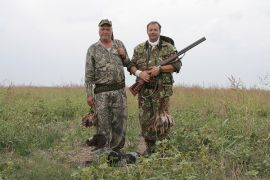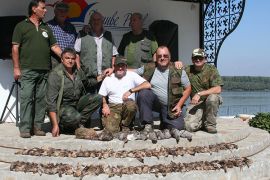Quail hunting trips in Bulgaria - Hunting area Самоков 2000
Quail shooting in Bulgaria - Hunting area Самоков 2000
Quail hunting in Bulgaria - Hunting area Самоков 2000
Quail shooting in Europe - Hunting area Самоков 2000
Quail hunting in Europe - Hunting area Самоков 2000
Quail hunting in Bulgaria
Bulgaria Hunting Trips - Discounted quail hunting trips on bghunters.com - Small game hunting area Самоков 2000
» Bulgaria Hunting Trips » Quail hunting in Bulgaria » Hunting area Самоков 2000
- Hunting trips directly from outfitters:
Quail hunting trips in Bulgaria
Hunting area Самоков 2000
We hunt some of the best areas for Quails in Bulgaria!
Quail hunting period & methods
Quail hunting in Bulgaria season:
- Second Saturday of August - November 30
Small game standart price list
Quail
Quail is a migratory bird for BuIgaria. Its small size, sudden take-off, and swift flight make quail hunting one of the most dynamic and enjoyable experiences. The hunt is usually with pointing dogs. When spooked by the dog, the quail doesn’t fly on great distances and can be easily found again. Quail meat is a real delicacy, especially at the end of the season, when birds have more fat.
Scientific Name: Coturnix coturnix
Habitat: Terrestrial species, feeding on seeds and insects on the ground. It is notoriously difficult to see, keeping hidden in crops, and reluctant to fly, preferring to creep away instead. Even when flushed, it keeps low and soon drops back into cover.
Description: Small, round bird, essentially streaked brown with a white eyestripe, and, in the male, a white chin. It measures roughly 18.0-21.9 cm and weighs 91-131 g.
Hunting method: Driven shoots, walking up.
Hunting available in: All areas of distribution in Bulgaria.
Accompanying hunt: It can be combined with Turtle Dove and European Hare hunting.
Hunting services: Standart price list
Bulgaria Hunting Trips | Hunting area Самоков 2000
- Лов Самоков 2000
- ✓ Hunting in Bulgaria Самоков 2000
- Hunting in Europe Самоков 2000
- Caccia in Bulgaria Самоков 2000
- Chasse en Bulgarie Самоков 2000
- Jagd in Bulgarien Самоков 2000
- Caza en Bulgaria Самоков 2000
- Κυνήγι στη Βουλγαρία Самоков 2000
- Bulgaristan'da Avcılık Самоков 2000
- ✓ Big game hunting in Bulgaria Самоков 2000
- Red deer hunting in Bulgaria Самоков 2000
- Fallow deer hunting in Bulgaria Самоков 2000
- Roe deer hunting in Bulgaria Самоков 2000
- Wild boar hunting in Bulgaria Самоков 2000
- Mouflon hunting in Bulgaria Самоков 2000
- Barbary sheep hunting in Bulgaria Самоков 2000
- Chamois hunting in Bulgaria Самоков 2000
- Himalayan tahr hunting in Bulgaria Самоков 2000
- Bezoar ibex hunting in Bulgaria Самоков 2000
- Wood grouse hunting in Bulgaria Самоков 2000
- ✓ Small game hunting in Bulgaria Самоков 2000
- Pheasant hunting in Bulgaria Самоков 2000
- Turtle-dove hunting in Bulgaria Самоков 2000
- Partridge hunting in Bulgaria Самоков 2000
- Wood pigeon hunting in Bulgaria Самоков 2000
- Woodcock hunting in Bulgaria Самоков 2000
- European hare hunting in Bulgaria Самоков 2000
- ✓ Waterfowl hunting in Bulgaria Самоков 2000
- Wild duck hunting in Bulgaria Самоков 2000
- Goose hunting in Bulgaria Самоков 2000
- ✓ Predator hunting in Bulgaria Самоков 2000
- Wolf hunting in Bulgaria Самоков 2000
- Jackal hunting in Bulgaria Самоков 2000
- Fox hunting in Bulgaria Самоков 2000
Quail hunting trips in Bulgaria
Small game - Quail shooting in Bulgaria
- Quail hunting in Bulgaria
- Самоков 2000
Quail hunting in Bulgaria
Quails hunting trips in Bulgaria
Quail hunting in Bulgaria - one of the two types of wing shooting in Bulgaria that can take place as early as August. Quail hunting is carried out primarily in the early hours of the day. It’s recommended you be at the hunting grounds by 6:00 AM.
In the beginning of the season, it is best you hunt until 10:00 AM and from 16:00 to 19:00 in the afternoon because of the high temperatures which impede the dogs work. During that period, it’s advisable you choose hunting grounds that are at greater altitudes. Practice shows us that quails prefer higher mountainous regions when the temperatures start to rise. They are most commonly encountered in meadows where different sorts of millet grow, in flat fields of harvested grain crops or the so called stubble fields where weeds are dominant.
The use of dogs of English breed (Pointer, Setter, etc.) is recommended. Hunting quails in passages is the most intense and successful method, when groups of 1000 to 3000 birds are formed. The season for this kind of wing shooting in Bulgaria is from the 1st of September to the 1st of October. During this period, temperatures are lower and it’s possible to hunt throughout the course of the entire day. A single hunter can shoot more than 100 birds during this type of hunt.
If the dogs are well trained, it is possible to shoot around 15 - 30 quails in about 2 - 4 hours. Our advice is to only shoot when the dog is in its pointing stance. That way there is equality between the hunter and the prey, and the hunt itself is pleasant. The dog has to be well trained, have a firm pointing stance and be a good retriever.
Young dogs can be brought along on this hunt, because they gain qualities and experience, making them better helpers when hunting other types of birds. The dog must work hard to find the game and, after the shot, bring it back to the hunter. If it learns to find quails then it will be able to find all other types of birds with ease. The recommended shooting distance is 20 to 30 meters. When the dog is standing still but there is nothing in front of it, it should be allowed to pick up the scent of the fleeing animal.
During group hunts the participant have to walk slowly and stop every 10 - 15 paces for about 30 seconds. That way the birds that press themselves down to the ground are forced to leave their cover and the dogs are given a chance to pick up their scents. When hunting in a group (4 - 5 hunters) we must always know the position of our fellow hunters. Whenever a person from the group fires their gun in an attempt to shoot down a bird, the others have to wait for him and then fire. Usually a region is searched with the group forming a line, complying with the safety measures.
The quails are completely wild; the populations are not mixed with birds raised in captivity. The best hunting period starts on the 1st of September and ends on the 1st of October. The hunting terrains are mountainous, hilly and farmlands.
- BOOK YOUR HUNT IN BULGARIA
Чакал
(Lepus europeus)
Срокове на ловуване
Ловът на чакали е разрешен целогодишно.
Групов лов на чакал извън горския фонд - от 1 януари до последния ден на февруари.
Препоръчителни патрони със съчмен заряд за отстрел на чакал
Екипът на БГ Ловци (bghunters.com) Ви препоръчва следните патрони:
- Препоръчителни патрони - 32g-50g за 12 кал.
- № на сачмите - 2/0, 4/0, 6/0, 8/0
- Разстояние - 35-45 метра
Разпространение на чакала
Чакалът е повсеместно разпространен в Мала Азия, Северна Африка и Югоизточна Европа. В недалечно минало у нас видът се считаше за рядък вид и отстрелът му бе забранен. През последните няколко години се наблюдават значително увеличаване на неговата численост и разширение на ареала му, и в някои райони по отношение на него се налагат ограничителни мерки.
Общи сведения за чакала
В систематично отношение принадлежи към семейство Кучета, като прилича на вълка, но е по-дребен от него. Цветът на козината му е сиво-жълта. По гърба тя е с тъмен оттенък, а отстрани, по врата, по краката и от двете страни на главата е златистожълт. Опашката му е рунтава с жълто-сив цвят и с отделни по-тъмни петна, краят й е черен. На дължина тялото на чакала достига 100-120 сm, а опашката 20-30 сm.
Начин на живот и хранене на чакала
Чакалът ловува предимно нощем. По принцип е всеяден, като се храни с мърша и дребни животни. Изяжда яйцата на гнездящите по земята птици, причинява значителни щети на ловното стопанство, като унищожава зайците, фазаните и яребиците, сърнета, малките на елена-лопатар и др., яде плодове, дини и пъпеши. Чакалът живее поединично. След мръкване вие по особен начин, наподобяващ плач, на което отговарят всички чакали в района.
Размножаване при чакала
Любовният период е през март. Бременността продължава 60-63 дни. Женската ражда 4-5, рядко повече малки в просто устроени дупки в земята.
Стопанско значение на чакала
Чакалът е отнесен към групата на вредния дивеч. Ловува се чрез хайка или примамване с мърша. Кожата му не се цени. Като трофей се оформя главата с челюстите и кожата.


